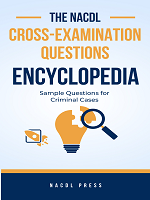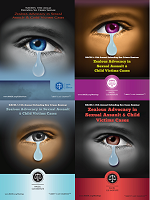Access to The Champion archive is one of many exclusive member benefits. It’s normally restricted to just NACDL members. However, this content, and others like it, is available to everyone in order to educate the public on why criminal justice reform is a necessity.
Sentencing policies in the United States are in drastic need of reform for many reasons, but in this column I want to focus on the harshness of our sentencing policies and the need for innovative alternatives.
Many have complained about the draconian nature of our sentences. Few recognize, however, that almost 132,000 of those incarcerated in the United States are serving a life sentence.1 That means that one of every eleven inmates is now serving a life term. By 1997, the actual time served by those with life sentences had increased to 29 years.2 About a third of those prisoners between 1998 and 2001 were serving time for offenses other than murder — including burglary and drug offenses. Indeed, sixteen percent of people serving life were convicted of drug trafficking.3 The composition of the population serving life sentences has changed in large part because of the frequency of imposing life for drug offenses and the “three strikes” legislation in California and other states.4
The harshness of the “get tough on crime” legislation, such as California’s three-strikes provision, becomes real when you look at some of the people who are affected by it. For example:
In 2003 a federal appeals court upheld a “three strikes” sentence of 26 year to life for Santos Reyes, whose third strike in California involved trying to take the written portion of a driver’s license test for his illiterate cousin. . . . Reyes admitted his perjury in filling out the license application, stating that his cousin needed the license in order to work as a roofer. The conviction followed two previous offenses, one for a juvenile burglary conviction in 1981 and another for an adult robbery conviction in 1987. Reyes had been offered a four-year prison term if he pled guilty, but chose to go to trial, believing he could demonstrate that he had not understood what constituted perjury when he took the exam. At the time of his sentencing in 1998, Reyes was married and had children ages 1 and 3.5
A life sentence in such a situation makes no sense.
Policy changes in recent years have also increased the number of those serving a sentence of life without parole. One of every four people serving a life sentence — over 33,000 — can never be paroled.6 Of that number, approximately 2,200 are serving LWOP sentences for crimes they committed before turning 18. More than 350 of those were 15 or younger.7
Many of the prisoners serving life sentences and all of those serving life without parole will grow old and die in prison. At the Louisiana State Prison in Angola, for example, “more than 3,000 of the 5,100 prisoners are serving life without parole, and most of the rest are serving sentences so long that they cannot be completed in a typical lifetime.”8 Eighty-five percent of the men at Angola will die there.9
Nationally, the costs of housing and caring for such prisoners will be huge. Some estimate that it costs $3 billion a year to house the prisoners serving life;10 and as they age, the costs of medical care will be astronomical. California, for example, spends $30,929 on average per inmate a year. It spends 2 to 3 times more a year housing inmates over the age of 55, of which there are currently 6,400 in state facilities. A state Legislative Analysts Office study projects that the number of inmates over 60 could hit 30,200 by 2022, costing the state at least a billion dollars a year.11
Sandra Kobrin in an Los Angeles Times story brought home the absurdity and inhumanity of these policies when she wrote:
It’s still dark when inmate No. 41465 wakes up to begin her day. The shrunken 82-year-old changes from her pajamas and pink house coat into jeans and a denim shirt labeled California Prisoner and begins her drill: breakfast at 6, sack lunch pickup at 6:30, infirmary at 7, where she acquires an ankle chain, belly chains and handcuffs. She then hobbles to a van for a 40-minute ride to Riverside Hospital for dialysis beginning at 8. Helen Loheac suffers from chronic renal failure, a condition that she figures costs the state $436,000 a year, not counting the two $24.75-an-hour armed corrections officers who guard her, all 5 feet and 90 pounds, for up to eight hours a day three times a week.12
Investments in alternatives to incarceration would be far more cost effective in reducing crime. Indeed, RAND researchers have documented that a $1 million investment in intervention programs, such as “providing cash and other incentives for disadvantaged students to graduate from high school would result in a reduction of 258 crimes per year and parent training and therapy for families with young ‘acting out’ children 160 crimes per year, compared to a reduction of 60 crimes a year through building and operating prisons.”13 Another RAND study “concluded that in addressing problems of drug abuse, spending $1 million on treatment programs would reduce serious crimes 15 times more effectively than incapacitating more offenders.”14
Less visible but equally significant are the societal costs incurred because so many parents are incarcerated. At the end of 2004, 2.2 million persons were incarcerated in the United States.15 One out of every 138 people was in prison or jail;16 and 60 percent of the inmates were black or Hispanic.17 Women are the fastest-growing segment of the prison population primarily because of the federal sentencing guidelines that mandate long prison terms for drug offenders.18 Many of those women are mothers.
Too often we ignore the impact that the incarceration of a parent — either a mother or a father — has on the children who are left behind. While detailed statistics exist about many aspects of our prison system, no one knows the exact number of children with a parent behind bars. Apparently, no official body thinks it is sufficiently important to even ask if prisoners have children. Despite that, estimates are that approximately 1.5 million children currently have a parent in prison.19 Many of these children grow up in foster care or with grandparents or other relatives. Others bounce between temporary caregivers.
Not only do these children often face economic hardships, but the removal of a parent from the life of a child can profoundly affect that child’s life. Even when a parent has not been the most functional, many young children still experience a parent’s incarceration as abandonment.20 One 1985 study by Christina Jose-Kampfner, a graduate student at the University of Michigan, of children of incarcerated parents found that many showed symptoms of post-traumatic stress reaction. Seventy-five percent of the 5 to 16 year-olds she surveyed reported symptoms such as depression, difficulty sleeping or concentrating, flashbacks to their parent’s crimes or arrests. Studies also show that young children of incarcerated parents often experience “survivor guilt” and feel as if they are to blame for their parent’s disappearance. Older children may express their grief through aggressive behavior, leading to disciplinary problems in school and too often to juvenile court. Not surprisingly, up to one half of the male children of prisoners will go on to commit crimes themselves.21 Yet, virtually no programs take into account the needs of these children or their parents.22
We, as a society, will continue to pay the price for our current sentencing polices for decades to come — not just in terms of dollars but in human suffering. As an organization, NACDL must take a leading role in convincing our legislators that the time for creative cost-effective alternatives — not just longer prison sentences — has come.
Notes
- Adam Liptak, To More Inmates, Life Term Means Dying Behind Bars, The New York Times, October 2, 2005.
- Marc Mauer, et al., “The Meaning of ‘Life’: Long Prison Sentences in Context,” The Sentencing Project (May 2004) at 12.
- Liptak, Dying Behind Bars.
- Mauer, “The Meaning of Life,” at 13.
- Id. at 2.
- Id. at 9.
- Adam Liptak, Jailed for Life After Crimes as Teenagers, The New York Times, October 3, 2005.
- Liptak, Dying Behind Bars.
- Tanya Tillman, Hospice in Prison: The Louisiana State Penitentiary Hospice Program. Innovations in End-of-Life Care, 2000;2(3), www.edc.org/lastacts.
- Id.
- Mauer, “The Meaning of Life” at 9.
- Sandra Kobrin, Dying on Our Dime, Los Angeles Times (June 26, 2005).
- Marc Mauer, “Comparative Rates of Incarceration: An Examination of Causes and Trends,” The Sentencing Project, June 20, 2003 at 13 (citing Peter W. Greenwood, et al., “Diverting Children from a Life of Crime: Measuring Costs and Benefits,” RAND, 1996).
- Id. (citing J. Caulkins, et al., Mandatory Minimum Drug Sentences: Throwing Away the Key or the Taxpayers’ Money? Santa Monica: RAND).
- Paige M. Harrison and Allen J. Beck, “Prisoners in 2004,” Bureau of Justice Statistics Bulletin at 1 (October 2005).
- Id. at 2.
- Id. at 8.
- Id. at 4.
- Mauer, Comparative Rates at 14.
- See generally “Families Left Behind: The Hidden Costs of Incarceration and Reentry,” Urban Institute, Justice Policy Center (Revised June 2005).
- Nell Bernstein, “Left Behind: Tens of thousands of children have a parent behind bars. What are the social costs of their loss?” MotherJones.com (July 10, 2001).
- A few exceptions exist. Over ten years ago, PB&J Family Services in Albuquerque, New Mexico established the IMPACT Program that works with incarcerated parents of young children who are nearing release. The recidivism rate for those completing the program has been less than 10 percent.






